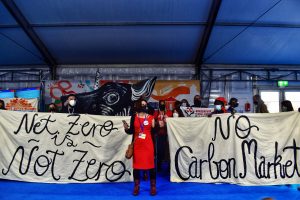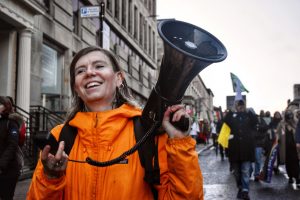
Was COP26 a success?
Despite the IPCC’s code red warning for humanity, and the grim reality that without deep, systemic changes we will hit the critical 1.5C threshold within the coming decade, the countries most responsible for causing the climate crisis came to Glasgow with pretty much nothing new in terms of how to solve it. As a result, the Glasgow Pact offers nothing but a few process hooks to cling onto for next year’s negotiations.
What needed to happen in Glasgow to unlock the long term tensions at the heart of the UN Framework Convention on Climate Change (UNFCCC) process was for rich historical polluters, including and especially the UK as COP Presidency, to come to the table with the political will and concrete policies to do their fair share of climate action. This means nations that have done the most to cause the crisis – the industrialised nations of the global north – cutting our emissions deepest and fastest, leaving what very little atmospheric space remains to poorer countries to have a bit extra time to decarbonise as they develop their economies.
It also means paying the substantial carbon debt we owe to countries on the frontline of the crisis in the global south through climate finance and other forms of support. This is not wild idealism; the principles of equity and ‘common but differentiated responsibility’ are enshrined in international law under the UNFCCC and must serve as a guide to global co-operation on the crisis.

Rich nations try to shift the burden
Instead, what we saw at COP26 was the US, EU, Canada, Australia, Japan and of course the UK continuing the pattern we’ve seen over the past decade of trying to shift the burden of responsibility for solving climate change onto the shoulders of the poorest. The UK Presidency is not alone in spinning the Glasgow Pact as a success, claiming the talks succeeded in ‘keeping 1.5C alive’ – but simply repeating the words without any action to get there is worse than meaningless, giving the illusion of momentum where there is none.
Take for example commitments to bring emissions down, and concrete policies to do so. Pledges submitted by parties to the Paris Agreement ahead of COP26 put the world on track for 2.4C warming, though policies to meet them take us to 2.7C. Hailed by many as proof the Paris Agreement is working – since these numbers are a marginal improvement on the last round of pledges – the fact remains that even 2.4C is far, far beyond the 1.5C threshold, more than enough to fry the planet and trigger tipping points that could cause climate change to spiral out of control.
Instead of inspiring confidence that even these targets would be met by committing to the sort of policies and actions that we know are needed, phasing out all fossil fuels for example, governments pushed through rules on carbon markets that were riddled with loopholes that allow themselves to keep polluting while giving the appearance of acting. Fossil fuels did make a historic appearance in the text of the Glasgow Pact, but the emphasis on coal puts the greater onus on poorer countries, letting richer countries off the hook in terms of their climate trashing oil and gas expansion plans.
Shamelessly, the Biden administration wasted no time in launching a huge licensing round in the Gulf of Mexico days after the summit closed, while the UK has 40 fossil fuel projects – the vast majority of which are oil and gas – in the pipeline for approval by 2025.
Where’s the money?

Climate finance is vital to help countries in the global south deliver their own climate plans – both reducing their own emissions and adapting to impacts of climate change – and therefore vital to engendering trust at the negotiation table.
At the Copenhagen summit in 2009, global north countries promised to deliver $100bn a year by 2020, split 50:50 between mitigation and adaptation. That target (which was plucked out of the air, not based on any actual analysis of what was needed or owed) was not met in 2020. Days before COP26 opened Alok Sharma presented a delivery plan to meet the totally inadequate missed target only by 2023.
At the talks themselves, global north countries refused to countenance poor countries’ proposals for a proper process to determine a new long term finance goal, while on short term needs the Glasgow Pact does little but weakly ‘urge’ developed countries to deliver on the $100bn goal, and balance finance between mitigation and adaptation.
Faced with the financial crisis governments very rapidly found trillions to bail out the banks deemed too big to fail. Similarly, faced with the Covid-19 pandemic, governments found trillions for fiscal support packages. Yet faced with the truly existential threat of climate catastrophe within the all too foreseeable future, governments are choosing not to cough up the mere billions they’ve committed to, to say nothing of the actual trillions required.
Take loss and damage – a concept that recognises that it is no longer possible to adapt to all of the impacts of climate change, whether the human and economic losses from repeat thrashings of extreme weather events, or indeed the loss of whole communities and nations when parts of the world become uninhabitable as a result of sea level rise or extreme heat.
Poor countries were powerfully united at COP26 in their demands for financial support for loss and damage – support they would likely not have needed if rich countries had acted on emissions sooner and delivered the finance they owe. But rich countries played a dirty game, pushing discussions into and out of various negotiation strands, with the US ultimately (and not for the first time) blocking any meaningful progress on this front. Instead of committing to finance or any other support for loss and damage the Glasgow Pact establishes a process for dialogue: let’s talk about your house burning down for next three years instead of actually helping you to rebuild it.
Hope lies in the movements

Hope, then, is clearly not to be found inside the UNFCCC process at present, nor in the outcome of COP26. Even the plants in the SEC were dying only half way through the summit.
But where hope does lie, and was in abundance during the fortnight of the talks, is in the movements organising around the summit for a climate just future.
Each day on the streets of Glasgow saw people taking action to send a clear message about what’s needed to turn the climate crisis around, from protesting the new oil field at Cambo to demanding free public transport, to solidarity on the picket lines with striking refuse workers, and marching with migrant justice justice groups. Over 150,000 people came together in the biggest climate march ever in the UK, a march that was visibly and powerfully led by Indigenous and frontline communities, while a further 300 actions around the world including 80 in the UK took place.
Daily movement assemblies on climate justice thematics were a space to connect and learn from different struggles. A Peoples’ Plenary was held inside the SEC, condemning the failure of world leaders to step up to their responsibility and bringing together collective demands to turn the crisis around, temporarily transforming the main COP26 plenary room into a space of hope, where the real solutions to the climate crisis were articulated and celebrated.
All this activity did not just happen spontaneously. It happened because we have been organising together for the past two years across NGOs, youth, trade unions, faith groups, migrant and racial justice groups, direct action networks, climate justice groups, under the umbrella of the COP26 Coalition to deepen our understanding of the drivers of the climate crisis and help shape the narrative around what needs to happen to turn it around.
Organising to build a strong and diverse movement of movements that recognises the root cause of the climate crisis is an economic system which is also driving multiple other injustices we are struggling against – poverty, racism, sexism, nature destruction to name but a few – and that only by coming together can we hope to make the change that we need to see happen.
What next for Scotland’s climate movement?

Now that COP is over, after some time for rest and reflection, our job is to build on the momentum and possibilities that organising around a summit of this kind creates in the host country and city. The greater understanding of what is at stake that comes from having to engage with a thing like COP26, not just in civil society, but also in the media where so much of our influencing work takes place and the political spaces in which we do our advocacy, means the landscape we are operating in is transformed.
We can dare to demand and hope for the transformative policies we know are needed to calm this crisis down. Crucially, we must actively bring into our work a new or revitalised awareness of the global injustices at play in the climate crisis and ensure the solutions we organise and advocate for here in Scotland do not further exacerbate these. If it wasn’t already clear before hearing from frontline voices in the various spaces around COP26: a transition for the global North that relies on continued exploitation of Southern resources, and fails to do our fair share of climate action, is not a just transition at all.
What that means concretely here in Scotland is forgetting about the longer term climate targets and focussing on bringing emissions down sharply over the next decade. A true fair share of climate action here in the UK looks something like a physically impossible 200% reduction in emissions by 2030. More realistically that translates into zero by 2030 plus £1trillion climate finance: the longer it takes us to reach zero, the greater the climate debt we owe.
It means building on the successes of the formidable Stop Cambo campaign which has, in a matter of mere months, leveraged the hosting of COP26 to first turn around long standing Scottish Government policy on drilling every last drop of oil and gas from the north sea, then cause Shell to pull out and private equity backed Siccar Point to shelve the project. There are a further 36 oil and gas projects and 3 coal projects in the planning, none of which can be allowed to go ahead if we want a climate safe future.
It means the forthcoming just transition plan for the energy sector must move beyond government rhetoric and come up with concrete policies and finance for delivering decent green jobs here in Scotland, with support and protection for workers and communities as regional economies inevitably go through significant changes. It means politicians no longer listening to oil and gas bosses and looking clear-eyed at the timescales and maths of the tantalising but ultimately false solutions of carbon capture and storage and hydrogen being touted by industry. The corporations who have knowingly got us into this mess have no place in getting us out for it, other than stumping up the funds to help.
We are way beyond the low hanging fruit of emissions reductions. It’s time for the difficult decisions and transformative policies, the ones that can both save our skins and make the world a better and more equal place in the process.
